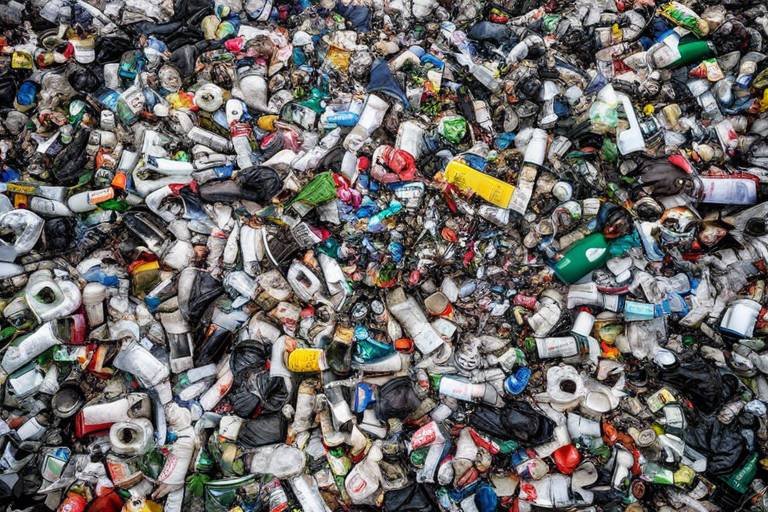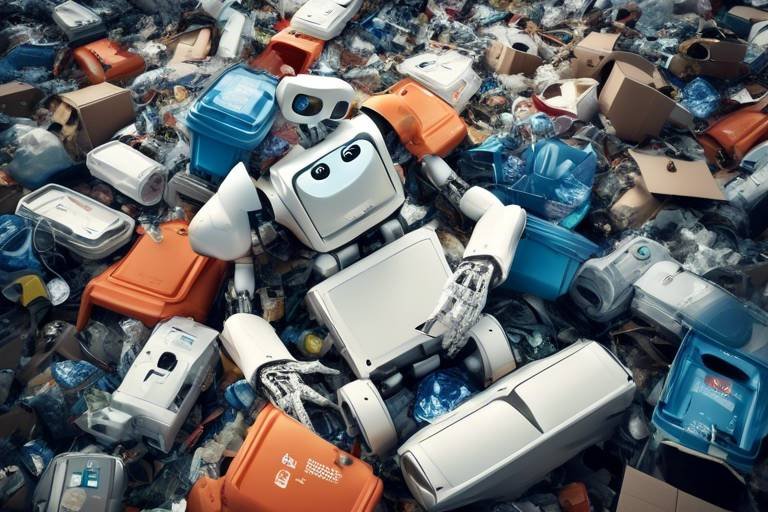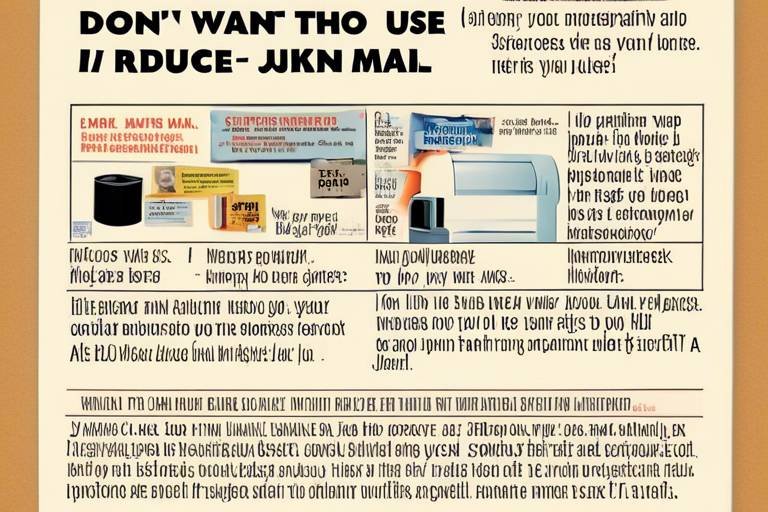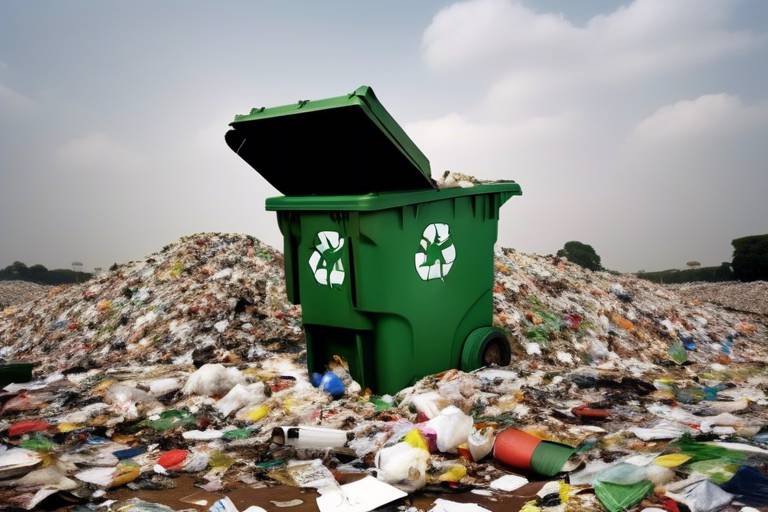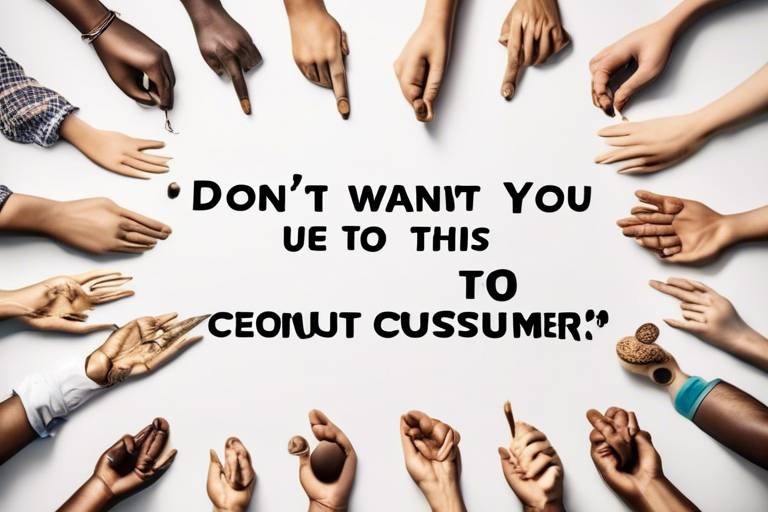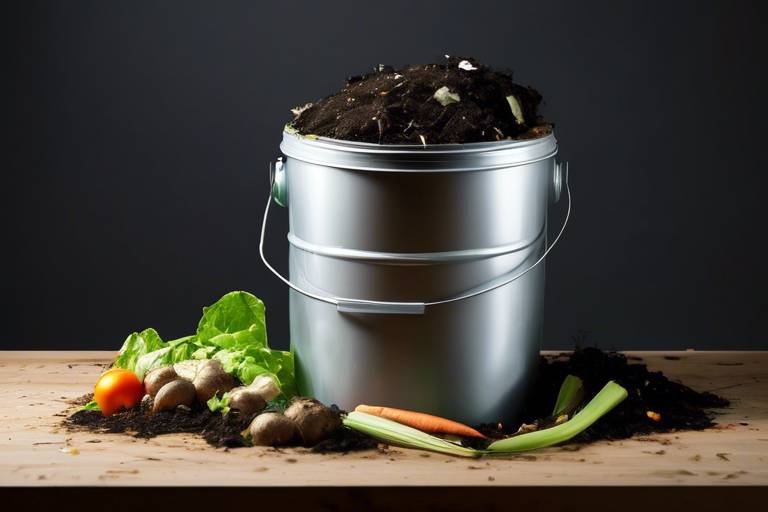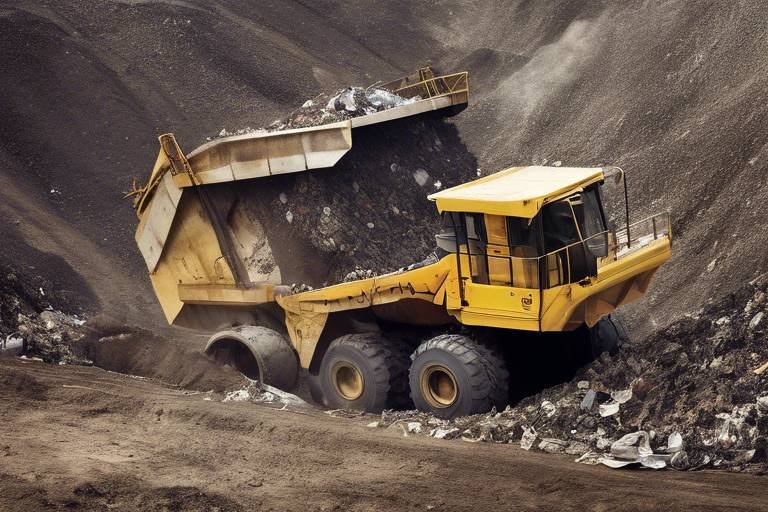The Cost of Plastic Pollution on Wildlife
The world we live in is increasingly choked by plastic waste, and the consequences are dire. This article explores the detrimental effects of plastic pollution on wildlife, examining its impact on ecosystems, animal health, and conservation efforts. As we delve into this pressing issue, it's essential to understand that the crisis of plastic pollution is not just an environmental concern; it is a grave threat to biodiversity and the very fabric of our ecosystems. The urgency for action cannot be overstated, as we are at a critical juncture where our decisions today will shape the future of wildlife and our planet.
Plastic pollution significantly harms marine ecosystems, leading to the ingestion and entanglement of marine animals. Imagine a sea turtle mistaking a plastic bag for a jellyfish, its favorite food. This tragic scenario is all too common and highlights the various ways plastic affects fish, sea turtles, and other marine species. Plastic debris in our oceans can take many forms, from microplastics to large fishing nets, and each piece poses a unique threat to marine life. The consequences are devastating: marine animals often suffer from malnutrition, internal injuries, and even death due to the ingestion of plastics.
But it's not just marine life that suffers; land animals are also affected by plastic waste. The health issues and habitat destruction caused by plastic pollution extend far beyond the shores. Animals living in proximity to human activities often encounter plastic debris, mistaking it for food or becoming entangled in it. The result? A grim reality where wildlife faces increasing threats to their survival. The effects on terrestrial wildlife can be profound, leading to a cascade of consequences that disrupt entire ecosystems.
Many terrestrial animals mistakenly ingest plastic, thinking it is food. This alarming trend is not just a minor inconvenience; it has serious health consequences for various species. For instance, animals that consume plastic can suffer from malnutrition as they fill their stomachs with indigestible materials instead of nutritious food. Additionally, internal injuries can occur, leading to painful conditions and often resulting in a slow, agonizing death. The issue of plastic ingestion is a ticking time bomb, threatening wildlife across the globe.
Consider the plight of the California sea lion, a species severely impacted by plastic ingestion. These animals often consume plastic debris while hunting, leading to dire health consequences. In one study, researchers found that over 50% of examined sea lions had ingested plastic. This statistic is just one example among many, showcasing the urgent need for conservation efforts to protect these species. Each case study serves as a chilling reminder of the impact of our choices on wildlife.
Exploring the long-term health implications of plastic consumption in wildlife reveals even more alarming trends. Chronic exposure to toxins leaching from plastics can lead to reproductive issues and other serious health problems. For example, studies have shown that certain chemicals found in plastics can disrupt hormonal systems in animals, leading to reduced fertility rates and increased susceptibility to diseases. The long-term effects of plastic pollution are a ticking time bomb, threatening not just individual species but entire ecosystems.
Plastic pollution contributes to habitat degradation, affecting the living conditions of numerous species. When litter and debris accumulate in natural habitats, they alter ecosystems and disrupt wildlife habitats. For instance, plastic waste can smother coral reefs, block sunlight, and hinder the growth of essential marine flora. On land, plastic can choke rivers and streams, disrupting the delicate balance of freshwater ecosystems. The degradation of habitats is a silent killer, often going unnoticed until it's too late.
The economic impact of plastic pollution extends beyond wildlife to fisheries and tourism. Communities that rely on fishing for their livelihoods are particularly vulnerable to the effects of plastic waste. As fish populations decline due to pollution, the economic implications are profound, threatening food security and local economies. Additionally, tourism industries suffer due to polluted environments, which can deter visitors and lead to significant financial losses for communities dependent on tourism.
Plastic pollution threatens fish populations, which can lead to economic losses for communities dependent on fishing. The implications for livelihoods are staggering, as fishermen struggle to catch healthy fish in polluted waters. This not only affects their income but also has a ripple effect on local markets and food security. The health of our oceans is directly tied to the economic well-being of many communities, making it imperative to address this crisis.
The tourism industry also bears the brunt of plastic pollution. Polluted environments can deter visitors, leading to a decline in tourism revenue. The financial burden of cleaning up plastic waste falls on local governments and conservation organizations, diverting resources from essential conservation efforts. Investing in clean environments is not just an ecological necessity; it is an economic imperative that can drive sustainable growth.
- What are the main sources of plastic pollution? Plastic pollution primarily comes from single-use plastics, improper waste disposal, and industrial runoff.
- How does plastic pollution affect animal health? Animals can ingest plastic, leading to malnutrition, internal injuries, and exposure to harmful chemicals.
- What can be done to combat plastic pollution? Reducing single-use plastics, increasing recycling efforts, and supporting conservation initiatives are crucial steps.
- Why is plastic pollution a concern for conservation? Plastic pollution threatens biodiversity, disrupts ecosystems, and poses significant challenges for wildlife conservation.

The Impact on Marine Life
Plastic pollution is wreaking havoc on our oceans, and the consequences for marine life are nothing short of catastrophic. Every year, millions of tons of plastic find their way into the sea, where it transforms into a deadly cocktail of hazards for countless marine species. From the tiniest plankton to the largest whales, no creature is immune to the dangers posed by plastic waste. Imagine a fish swimming through its home, only to encounter a swirling mass of plastic debris instead of the vibrant coral reefs it once knew. This is the grim reality of our oceans today.
One of the most alarming impacts of plastic pollution is the ingestion of plastic by marine animals. Species such as fish, sea turtles, and seabirds often mistake plastic for food. This can lead to serious health issues, including malnutrition, intestinal blockages, and even death. For instance, a recent study revealed that over 50% of sea turtles have ingested plastic at some point in their lives. This alarming statistic highlights the urgent need for action to protect these magnificent creatures.
Moreover, entanglement in plastic debris poses another significant threat to marine wildlife. Animals like seals, dolphins, and sea turtles can become ensnared in discarded fishing nets, six-pack rings, and other plastic materials. This entrapment can result in severe injuries, restricted movement, and often a slow and painful death. In fact, it's estimated that around 100,000 marine mammals die each year due to entanglement in plastic waste. The visual of a majestic sea lion struggling to free itself from a net is heartbreaking, and yet, it’s a sight becoming all too common.
| Marine Species | Common Issues Caused by Plastic Pollution |
|---|---|
| Fish | Ingestion leading to malnutrition and internal injuries |
| Sea Turtles | Ingestion and entanglement causing injury and death |
| Seabirds | Ingestion leading to starvation and toxicity from plastic pieces |
| Marine Mammals | Entanglement causing injuries and death |
Another critical aspect to consider is the microplastics that have infiltrated marine ecosystems. These tiny plastic particles, often less than 5mm in size, are consumed by small marine organisms, which then enter the food chain. As larger predators consume these smaller creatures, the toxins associated with microplastics accumulate, leading to potentially devastating effects on entire populations. It’s a vicious cycle that not only threatens the health of marine life but also poses risks to human health as we consume seafood.
In conclusion, the impact of plastic pollution on marine life is profound and multifaceted. It affects the health, survival, and reproductive success of countless species, disrupting entire ecosystems. The urgency of this crisis cannot be overstated; the time to act is now. By raising awareness and implementing effective policies, we can begin to turn the tide against plastic pollution and protect our precious marine wildlife.
- What are microplastics? Microplastics are tiny plastic particles that result from the breakdown of larger plastic items and can be harmful to marine life.
- How does plastic pollution affect human health? As plastics break down in the ocean, toxins can accumulate in seafood, potentially impacting human health when consumed.
- What can be done to reduce plastic pollution? Reducing single-use plastics, supporting clean-up initiatives, and advocating for policy changes are crucial steps toward mitigating plastic pollution.

Effects on Terrestrial Animals
The impact of plastic pollution isn't confined to the oceans; it stretches across the land, affecting a myriad of terrestrial animals. Imagine walking through a beautiful forest or a vibrant savanna, only to find plastic wrappers and bags littering the ground. This not only ruins the scenery but also poses a significant threat to wildlife that call these habitats home. From small rodents to large mammals, the consequences of plastic waste are dire and far-reaching.
One of the most alarming effects of plastic pollution on terrestrial animals is the health issues it causes. Animals often encounter plastic waste in their environment, mistaking it for food. This is particularly problematic for herbivores, who may consume plastic bags, bottles, and other debris while foraging. The ingestion of plastic can lead to severe health complications, including malnutrition, internal injuries, and even death. For instance, studies have shown that animals like cows and deer can suffer from gastrointestinal blockages due to plastic consumption, which can be fatal if not treated.
Additionally, habitat destruction plays a crucial role in the plight of terrestrial wildlife. As plastic waste accumulates in natural habitats, it can alter the landscape and disrupt the delicate balance of ecosystems. For example, plastic litter can choke vegetation, making it difficult for animals to find food and shelter. The presence of plastic can also attract invasive species, which may outcompete native wildlife for resources. This degradation of habitat not only threatens individual species but can also lead to broader ecological consequences, affecting the entire food chain.
When we think about the ingestion of plastics by terrestrial animals, it’s essential to understand the gravity of the situation. Many animals, including birds, mammals, and even insects, are prone to ingesting plastic materials. This is often due to a phenomenon known as food confusion, where animals mistake plastic for food. For example, seabirds are notorious for this; they often consume plastic debris, thinking it’s fish or other marine life. The repercussions are staggering—plastic can cause a range of health issues from physical blockages to toxic chemical exposure.
Numerous case studies highlight the devastating impact of plastic on terrestrial wildlife. For instance, the case of the California condor is particularly poignant. This magnificent bird has been found with plastic in its stomach, leading to malnutrition and even death. Similarly, studies on sea turtles have shown that those that venture onto land can also fall victim to plastic pollution, mistaking plastic for food. These examples underscore the urgent need for conservation efforts to protect these vulnerable species.
The long-term health effects of plastic consumption in wildlife are alarming. Research indicates that animals ingesting plastics can suffer from chronic illnesses, reproductive issues, and even genetic mutations. The toxins that leach from plastics into the bodies of these animals can disrupt hormonal systems, leading to a host of reproductive challenges. Imagine a world where the natural rhythms of wildlife are thrown off balance because of our reliance on plastic—it’s a stark reality that we must confront.
Plastic pollution contributes significantly to habitat degradation, further complicating the survival of terrestrial species. As plastic waste accumulates, it alters the physical environment, affecting soil quality and water sources. This degradation can lead to a decline in biodiversity, as some species struggle to adapt to the changing conditions. For example, the presence of plastic in soil can affect plant growth, limiting the availability of food for herbivores and, consequently, the predators that rely on them. The ripple effects of plastic pollution are profound and far-reaching, impacting entire ecosystems.

Ingestion of Plastics
Imagine walking through a beautiful forest or along a pristine beach, only to find bits of plastic scattered everywhere. It's a shocking reality that many of our beloved terrestrial and marine animals face daily. happens when animals mistake plastic debris for food, leading to a host of health problems that can be devastating. This is more common than you might think, especially for species like seabirds, turtles, and even terrestrial mammals. They often see brightly colored plastic items and, in their quest for food, consume these harmful materials.
When animals ingest plastic, the consequences can be dire. For instance, birds that consume plastic can suffer from malnutrition because their stomachs fill with indigestible materials, leaving no room for actual food. This can lead to starvation, which is particularly tragic given that these birds are often vital components of their ecosystems. Similarly, marine species like fish and turtles can experience internal injuries, blockages, and even death as a result of consuming plastic debris.
To put this into perspective, consider the following statistics about plastic ingestion in wildlife:
| Species | Percentage Affected | Health Issues |
|---|---|---|
| Seabirds | 90% | Malnutrition, internal injuries |
| Sea Turtles | 50% | Intestinal blockages, death |
| Fish | 30% | Growth issues, reproductive problems |
As you can see, the numbers are alarming. The ingestion of plastics not only affects individual animals but also has cascading effects on entire ecosystems. For instance, when fish consume plastic, toxins can leach into their bodies, making them less healthy and potentially unsafe for humans who consume them. It's a vicious cycle that underscores the urgent need for action.
Moreover, the health consequences of plastic ingestion can extend beyond immediate effects. Research has shown that animals suffering from plastic ingestion may face long-term health challenges, including reproductive issues and chronic illnesses. The toxins released from plastics can disrupt hormonal systems, leading to decreased fertility and other serious health concerns. This is particularly troubling for species already under threat from habitat loss and climate change.
In conclusion, the ingestion of plastics is a critical issue that cannot be overlooked. As stewards of the planet, we must advocate for change, whether that means supporting clean-up initiatives, reducing our plastic consumption, or raising awareness about the plight of wildlife affected by plastic pollution. The health of our ecosystems—and ultimately our own well-being—depends on it.

Case Studies of Affected Species
Plastic pollution has become a silent killer, affecting numerous animal species across the globe. To illustrate the severity of this issue, let's delve into some case studies that highlight the impact of plastic ingestion on wildlife. These examples serve as a wake-up call, emphasizing the urgent need for conservation efforts.
One of the most heartbreaking cases involves the sea turtle. These magnificent creatures often mistake plastic bags for jellyfish, a staple in their diet. A study conducted in 2015 revealed that over 50% of sea turtles had ingested plastic at some point in their lives. The consequences are dire; many turtles suffer from internal injuries, malnutrition, and even death. Imagine a creature that has roamed the oceans for millions of years, now facing extinction because of something as trivial as a plastic bag.
Another striking example is the albatross, a bird known for its incredible wingspan and long-distance flying abilities. Unfortunately, these birds are also victims of plastic pollution. Research shows that many albatrosses are found with their stomachs filled with plastic debris, mistaking it for food. In one notable case, a baby albatross was found dead on a remote island, its stomach containing over 200 pieces of plastic. This not only affects their health but also hampers their ability to reproduce, threatening the survival of the species.
The plight of the whale is equally alarming. In recent years, several whales have been discovered dead, their stomachs packed with plastic waste. A famous case in 2018 involved a sperm whale found off the coast of Italy, which had ingested more than 29 kilograms (about 64 pounds) of plastic. This incident shocked the world and sparked discussions about the dire consequences of our plastic habits. The toxic chemicals leached from plastics can disrupt hormonal functions and lead to reproductive issues, further endangering whale populations.
In addition to these animals, land mammals are not spared from the scourge of plastic pollution. A notable case involves the elephant, which can ingest plastic waste while foraging for food. In regions where human encroachment has destroyed natural habitats, elephants often wander into human settlements, leading to increased encounters with plastic waste. Many have been found with plastic lodged in their intestines, causing serious health complications and even death.
These case studies underscore the urgent need for action. The stories of these animals are not just isolated incidents; they represent a broader environmental crisis that demands our attention. We must advocate for stricter regulations on plastic production and waste management and promote awareness about the impact of plastic pollution on wildlife.
As we reflect on these heart-wrenching examples, we must ask ourselves: what can we do to protect these vulnerable species? By reducing our plastic consumption and supporting conservation efforts, we can help ensure that future generations will not only hear about these magnificent animals but also see them thriving in their natural habitats.
Q: What are the main sources of plastic pollution?
A: The primary sources of plastic pollution include single-use plastics, improper waste disposal, and industrial runoff. Everyday items like plastic bags, bottles, and straws contribute significantly to the problem.
Q: How does plastic affect marine life?
A: Marine life is severely impacted by plastic through ingestion and entanglement. Animals often mistake plastic for food, leading to internal injuries, malnutrition, and death.
Q: What can individuals do to reduce plastic pollution?
A: Individuals can help by reducing their use of single-use plastics, recycling whenever possible, participating in clean-up events, and advocating for policies that promote sustainable practices.
Q: Are there any successful conservation efforts addressing plastic pollution?
A: Yes, various organizations are working to combat plastic pollution through awareness campaigns, beach clean-ups, and policy advocacy. These efforts aim to protect wildlife and restore ecosystems affected by plastic waste.

Long-term Health Effects
The long-term health effects of plastic consumption on wildlife are alarming and multifaceted. When animals ingest plastic, they are not just consuming a foreign object; they are also introducing a cocktail of harmful chemicals into their bodies. These plastics can leach toxins into the animal's system, leading to a range of chronic health issues. For instance, many plastics contain additives like phthalates and bisphenol A (BPA), which are known endocrine disruptors. This means they can interfere with hormone systems, potentially leading to reproductive issues among affected species.
Moreover, the ingestion of plastics can lead to malnutrition. When animals consume plastic, their stomachs can become filled with indigestible materials, leaving little room for actual food. This can result in severe weight loss and nutrient deficiencies. Imagine trying to fill your stomach with rocks instead of food—eventually, it would take a toll on your health. This phenomenon is particularly concerning for species that already face environmental pressures, as their ability to find and consume adequate food sources is further compromised.
Additionally, the chronic exposure to plastic toxins can lead to long-term health complications, including:
- Reproductive Problems: Reduced fertility rates and developmental issues in offspring.
- Chronic Illnesses: Increased susceptibility to diseases and potential cancers due to toxic exposure.
- Behavioral Changes: Altered foraging and mating behaviors as a result of hormonal disruptions.
To illustrate the seriousness of these long-term health effects, consider the case of sea turtles, which are known to ingest plastic bags, mistaking them for jellyfish. The consequences are dire: studies have shown that turtles that consume plastic have a much higher risk of mortality than those that do not. This is a clear indication that the health of these animals is being severely compromised by our plastic pollution crisis.
In summary, the long-term health effects of plastic ingestion in wildlife are not just a ticking time bomb; they are a reality that is unfolding right before our eyes. As these animals struggle to survive in an increasingly plastic-laden world, the need for immediate action to reduce plastic pollution becomes more urgent than ever.
- What are the main health effects of plastic pollution on wildlife?
Plastic pollution can lead to malnutrition, reproductive issues, chronic illnesses, and behavioral changes in wildlife. - How does plastic ingestion affect marine animals differently than terrestrial animals?
While both marine and terrestrial animals suffer from ingestion, marine animals often face additional threats like entanglement and habitat degradation. - What can be done to mitigate the effects of plastic pollution on wildlife?
Efforts such as reducing plastic usage, improving waste management, and supporting conservation initiatives can help mitigate these effects.

Habitat Degradation
Plastic pollution is not just an eyesore; it is a silent killer that gradually degrades habitats across the globe. When we think of wildlife, we often picture majestic creatures roaming their natural environments, but what happens when those environments are littered with plastic? The impact is profound and multifaceted. Plastic waste disrupts ecosystems, leading to a chain reaction that affects both flora and fauna. Imagine a vibrant coral reef, once teeming with life, now suffocated by plastic debris. This degradation not only affects marine life but also ripples through the entire food chain, ultimately impacting terrestrial animals and humans alike.
One of the most alarming aspects of habitat degradation caused by plastic is how it alters the very structure of ecosystems. For instance, plastic waste can smother coral reefs, blocking sunlight and preventing photosynthesis. This leads to the decline of coral health, which is critical for the survival of numerous marine species. In terrestrial environments, plastic debris can choke rivers and streams, disrupting the natural flow of water and affecting the plants and animals that rely on these ecosystems. The result? A significant loss of biodiversity, as species struggle to adapt to the changing conditions.
Moreover, the presence of plastic in natural habitats can lead to the creation of microplastics, tiny particles that are ingested by animals, further complicating the issue. These microplastics can accumulate in the food web, posing health risks not only to wildlife but also to humans who consume contaminated seafood. The effects of plastic pollution are far-reaching, and the degradation of habitats is just one of the many consequences we face.
To put this into perspective, consider the following points:
- Altered Ecosystems: Plastic waste can change the dynamics of habitats, making them less hospitable for native species.
- Loss of Biodiversity: As habitats degrade, many species face extinction, leading to a less diverse ecosystem.
- Microplastic Contamination: The breakdown of plastics leads to microplastics entering food chains, affecting health at multiple levels.
In conclusion, the degradation of habitats due to plastic pollution is a pressing issue that cannot be ignored. It is a clarion call for action, urging us to rethink our relationship with plastic and take steps to protect our planet. By addressing this crisis, we can safeguard not just wildlife but also the intricate web of life that sustains us all.
- What is habitat degradation? Habitat degradation refers to the deterioration of the natural environment, making it less suitable for wildlife.
- How does plastic pollution contribute to habitat degradation? Plastic pollution alters ecosystems, disrupts food chains, and can lead to the extinction of species.
- What can be done to mitigate habitat degradation caused by plastic? Reducing plastic use, improving waste management, and participating in clean-up efforts are essential steps.
- Are there any laws addressing plastic pollution? Many countries are implementing regulations to reduce plastic use and promote recycling.

Economic Consequences
The economic impact of plastic pollution is a multifaceted crisis that extends far beyond the immediate environmental concerns. Communities around the world are feeling the pinch as plastic waste infiltrates their ecosystems, affecting industries that rely heavily on natural resources. Imagine a bustling fishing village that has thrived for generations, now facing dwindling fish populations due to the insidious effects of plastic. This is not just an environmental issue; it’s a matter of survival for many families and local economies.
First off, let's talk about fisheries. The fishing industry is particularly vulnerable to the repercussions of plastic pollution. Fish and other marine creatures often mistake plastic debris for food, leading to significant health issues and population declines. As fish stocks dwindle, fishermen find themselves struggling to make a living. According to recent studies, plastic pollution can lead to a 30% decrease in fish populations, which translates directly into lost income for those who depend on fishing. The ripple effects can be devastating, impacting not just the fishermen but also the local markets, restaurants, and families that rely on fresh seafood for their livelihoods.
Moreover, the cost of cleaning up plastic waste can be astronomical. Local governments and organizations are often left to foot the bill for cleanup efforts, which can amount to millions of dollars each year. These funds could be better spent on community development or conservation initiatives, yet they are diverted to combat the consequences of plastic pollution. For instance, a coastal city might allocate $500,000 annually just for beach cleanups, which could have been used for educational programs or infrastructure improvements.
Tourism is another sector feeling the heat from plastic pollution. Beautiful beaches and pristine natural parks attract millions of visitors each year, but when these areas are littered with plastic waste, it creates an uninviting atmosphere. Tourists are less likely to visit a destination that is marred by pollution, leading to a decline in revenue for local businesses. In fact, studies indicate that locations with high levels of plastic pollution can see a drop in tourist numbers by as much as 20% or more. This not only affects hotels and restaurants but also local artisans and service providers who depend on tourism for their income.
In light of these economic consequences, it becomes clear that addressing plastic pollution is not just an environmental imperative but a crucial economic strategy. Communities must come together to find innovative solutions to reduce plastic waste and promote sustainable practices. This could involve implementing stricter regulations on plastic production, encouraging recycling initiatives, or even supporting local businesses that prioritize eco-friendly practices. The goal should be to create a circular economy where plastic is reused and recycled, minimizing its impact on both wildlife and local economies.
In conclusion, the economic consequences of plastic pollution are profound and far-reaching. By understanding the interconnectedness of environmental health and economic vitality, we can begin to take meaningful steps towards a cleaner, more sustainable future. It’s not just about saving the planet; it’s about preserving livelihoods and ensuring that future generations can thrive in a world free from plastic pollution.
- What are the main economic impacts of plastic pollution?
Plastic pollution affects fisheries, tourism, and local economies by reducing fish populations, deterring tourists, and increasing cleanup costs. - How does plastic pollution affect fish populations?
Marine animals often ingest plastic, mistaking it for food, which can lead to health issues and declines in fish stocks. - What can communities do to combat plastic pollution?
Communities can implement recycling initiatives, support eco-friendly businesses, and advocate for stricter regulations on plastic use.

Impact on Fisheries
Plastic pollution is not just a problem for wildlife; it also wreaks havoc on our fisheries, which are vital for both local economies and global food security. Imagine a bustling fishing town, where fishermen cast their nets into the ocean, hoping to bring back a bountiful catch. Now, picture that same scene, but instead of fish, their nets are filled with plastic debris. This alarming reality is becoming all too common, and the consequences are dire.
The presence of plastic in our oceans leads to several detrimental effects on fish populations. First and foremost, fish often mistake plastic for food. When they ingest these materials, it can lead to serious health issues, including malnutrition and internal injuries. Moreover, the toxins that leach from plastics can accumulate in the fish, making them unsafe for human consumption. This poses a double threat: not only are we harming marine life, but we are also endangering our own health through the consumption of contaminated seafood.
Furthermore, the economic implications of plastic pollution on fisheries are staggering. According to recent studies, the global fishing industry generates over $200 billion annually, and a significant portion of this revenue is at risk due to declining fish populations caused by pollution. As fish become scarce, fishing communities face dwindling incomes, leading to increased poverty and food insecurity. The ripple effect of this crisis can be felt far beyond coastal towns, impacting global markets and supply chains.
To illustrate the economic impact of plastic pollution on fisheries, consider the following table:
| Impact | Consequences |
|---|---|
| Decreased Fish Populations | Lower catch yields, affecting livelihoods |
| Toxin Contamination | Health risks for consumers, impacting sales |
| Increased Cleanup Costs | Financial burden on local governments and communities |
| Decline in Tourism | Reduced income for fishing-related tourism activities |
In addition to direct effects on fish populations, plastic pollution also impacts the overall health of marine ecosystems, which are crucial for sustaining fisheries. Coral reefs, for instance, are often smothered by plastic debris, disrupting the habitats that many fish species rely on for spawning and growth. When these ecosystems are damaged, it leads to a decline in fish populations, further exacerbating the economic challenges faced by fishing communities.
The situation calls for immediate action. Fishermen, policymakers, and environmental organizations must come together to address the issue of plastic pollution in our oceans. Initiatives such as sustainable fishing practices, stricter regulations on plastic use, and community clean-up efforts can help mitigate the impact on fisheries. By working collaboratively, we can protect marine life, support local economies, and ensure a sustainable future for our oceans.
- What are the main causes of plastic pollution in oceans? Plastic pollution is primarily caused by improper waste disposal, littering, and industrial runoff.
- How does plastic ingestion affect fish? Plastic ingestion can lead to malnutrition, internal injuries, and the accumulation of harmful toxins in fish.
- What can be done to reduce plastic pollution? Strategies include reducing single-use plastics, promoting recycling, and participating in local clean-up efforts.
- How does plastic pollution impact human health? Consuming contaminated fish can lead to health risks due to the accumulation of toxins in the food chain.

Tourism and Conservation Costs
When we think about the impact of plastic pollution, it's easy to focus on the wildlife and ecosystems that are directly affected. However, the repercussions extend far beyond the natural world, reaching into the heart of local economies and the tourism industry. Imagine a picturesque beach, once a thriving tourist destination, now littered with plastic waste. This not only diminishes its beauty but also deters visitors, leading to significant economic losses for communities that rely on tourism as a primary source of income.
The financial burden of plastic pollution is staggering. Cleaning up polluted environments requires substantial investment, diverting funds that could be used for other crucial community services or conservation efforts. According to recent studies, regions inundated with plastic waste can see a decline in tourist numbers by as much as 30%. This decline translates into lost revenue for local businesses, affecting everyone from hotel owners to restaurant staff and tour guides.
Moreover, the costs associated with cleaning up plastic waste are not just limited to immediate financial expenses. They also include long-term conservation efforts aimed at restoring damaged ecosystems. The process of rehabilitating a polluted area can take years, if not decades, and requires ongoing funding and resources. For instance, some coastal towns have reported spending upwards of $1 million annually on cleanup efforts alone. This money could have been invested in sustainable tourism initiatives or community development projects that would benefit the area in the long run.
In addition to the direct costs of cleanup, there’s an indirect cost that often goes unnoticed—the loss of biodiversity. Tourists flock to areas renowned for their unique wildlife and natural beauty. When plastic pollution degrades these environments, it not only affects the local flora and fauna but also the overall appeal of the destination. As ecosystems collapse, so too does the allure that draws visitors in the first place. This creates a vicious cycle: less tourism leads to less funding for conservation, which in turn leads to further degradation of the environment.
The urgency of addressing plastic pollution cannot be overstated. It’s not just an environmental issue; it’s a matter of economic survival for many communities. Local governments and organizations are beginning to recognize this connection and are taking action. Initiatives like beach cleanups, educational programs, and sustainable tourism practices are being implemented to combat the crisis. However, these efforts require support from both the public and private sectors to be truly effective.
To wrap it up, the costs of plastic pollution on tourism and conservation efforts are profound and multifaceted. As consumers, we have the power to influence change by making conscious choices about our plastic use and supporting businesses that prioritize sustainability. Together, we can help preserve the beauty of our planet for future generations while ensuring the economic stability of communities that depend on tourism.
- What are the main causes of plastic pollution? Plastic pollution primarily stems from single-use plastics, improper waste disposal, and industrial runoff.
- How does plastic pollution affect wildlife? Wildlife can ingest plastic or become entangled in it, leading to serious health issues and even death.
- What can individuals do to reduce plastic pollution? Individuals can reduce their plastic footprint by using reusable bags, bottles, and containers, as well as participating in local clean-up efforts.
- How does plastic pollution impact local economies? Plastic pollution can deter tourists, leading to economic losses for businesses that rely on tourism and increasing cleanup costs for local governments.
Frequently Asked Questions
-
What is plastic pollution and why is it a problem for wildlife?
Plastic pollution refers to the accumulation of plastic products in the environment, which can cause significant harm to wildlife. It poses a threat to animals through ingestion or entanglement, leading to health issues, habitat destruction, and even death. The sheer volume of plastic waste in our oceans and on land creates a crisis that affects ecosystems and biodiversity.
-
How does plastic pollution specifically impact marine life?
Marine life is particularly vulnerable to plastic pollution. Animals like fish, sea turtles, and marine mammals often mistake plastic for food, leading to ingestion that can cause malnutrition, internal injuries, or even death. Additionally, entanglement in plastic debris can hinder their ability to move, feed, or reproduce, further threatening their populations.
-
Are terrestrial animals affected by plastic waste?
Absolutely! Terrestrial animals also suffer from plastic pollution. Many land animals inadvertently ingest plastic while foraging for food, which can lead to severe health problems. Moreover, plastic waste can destroy habitats, making it difficult for these animals to find shelter and food, ultimately threatening their survival.
-
What are the long-term health effects of plastic ingestion in wildlife?
The long-term health implications of plastic ingestion can be dire. Animals that consume plastic may experience reproductive issues, chronic illnesses, and other serious health problems due to toxins leaching from the plastics. This not only affects individual animals but can also have cascading effects on entire populations and ecosystems.
-
How does plastic pollution affect fisheries and local economies?
Plastic pollution poses a significant threat to fisheries by harming fish populations, which can lead to economic losses for communities that rely on fishing for their livelihoods. The decline in fish stocks can affect food security and local economies, making it vital to address this issue to sustain both wildlife and human communities.
-
What is the impact of plastic pollution on tourism?
Tourism can be severely impacted by plastic pollution, as polluted environments deter visitors. The costs associated with cleaning up plastic waste can also burden local governments and conservation efforts. Maintaining clean and beautiful natural spaces is essential for attracting tourists and supporting the economy.






